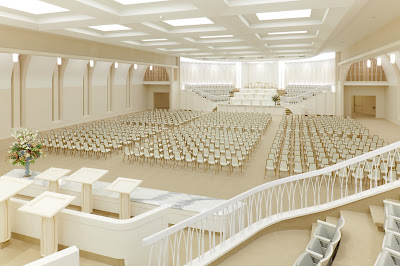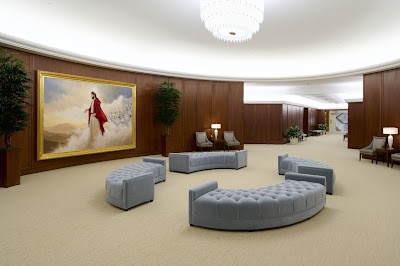 |
| Yigo Guam Temple Baptistry |
The Church of Jesus Christ of Latter-day Saints just started the open house for the Yigo Guam Temple. This temple is tiny by temple standards - just 6,861 square feet. For comparison, most small temples President Hinckley had built in the late 1990s and early 2000s were 10,700 square feet. So these are about 2/3 the size of those already quite small temples. Overall the temple is nice, albeit tiny. Several temples under construction are using this plan, so we will soon know if this is too small, or if it works well for remote areas such as Guam.
One interesting design element I liked in this temple is the baptismal font sculptures. Latter-day Saint temples typically have baptismal fonts that are supported by sculptures of 12 life-sized oxen. This is a reference to the Temple of Solomon in the Old Testament where there was a brazen sea supported by 12 bronze oxen representing the 12 tribes of Israel. This was almost certainly not used for baptisms, but instead for washings of the priests in the temple. The Church uses oxen for the baptismal font because baptism symbolically washes in Christianity in a way that is symbolically similar to the ritualistic washing in the ancient temples.
 |
| Yigo Guam Temple Font Sculpture |
Latter-day Saint temple font oxen have been in various styles from the highly realistic bronze of the Salt Lake Temple to the highly stylized ones in the Idaho Falls Idaho Temple. The Church has had some temples initially without oxen below the font. I think all of those had oxen added. Many temples have only the front of full sized oxen. Others have been built with six oxen and mirrors giving the illusion of twelve. Regardless of how the oxen are done, it is a symbol of baptism bringing people into the House of Israel. The Yigo Guam Temple (and presumably others of this style currently under construction) has very unique font sculptures. Instead of 12 full sized oxen, it has 12 relief sculptures of the heads of the oxen. I like this as an occasional design choice. I would love to see the sculpture slightly modified for each temple. I'm guessing they will just keep the one mold and make a bunch of identical oxen, but it would be interesting if they could make minor changes such as changing the cattails to something else, adding a bronze finish, giving different colors to the different elements like the Mesa Arizona Temple has, etc. There are a lot of possibilities to make each of these fonts unique that probably wouldn't cost much. I could even see fonts where the sculptures are flat with just the outlines of oxen are carved into the stone around the font in line art or where the oxen are completely flat backlit stained glass. I like the refreshing detail of relief sculptures for oxen around this temple's font, although I don't expect larger temples to use it.
If you have any thoughts on this temple or the oxen design, feel free to comment.


















